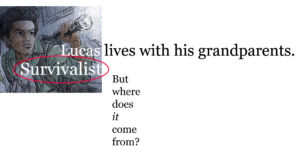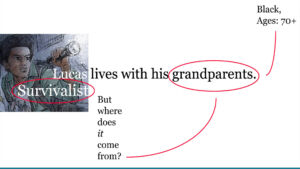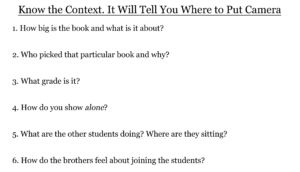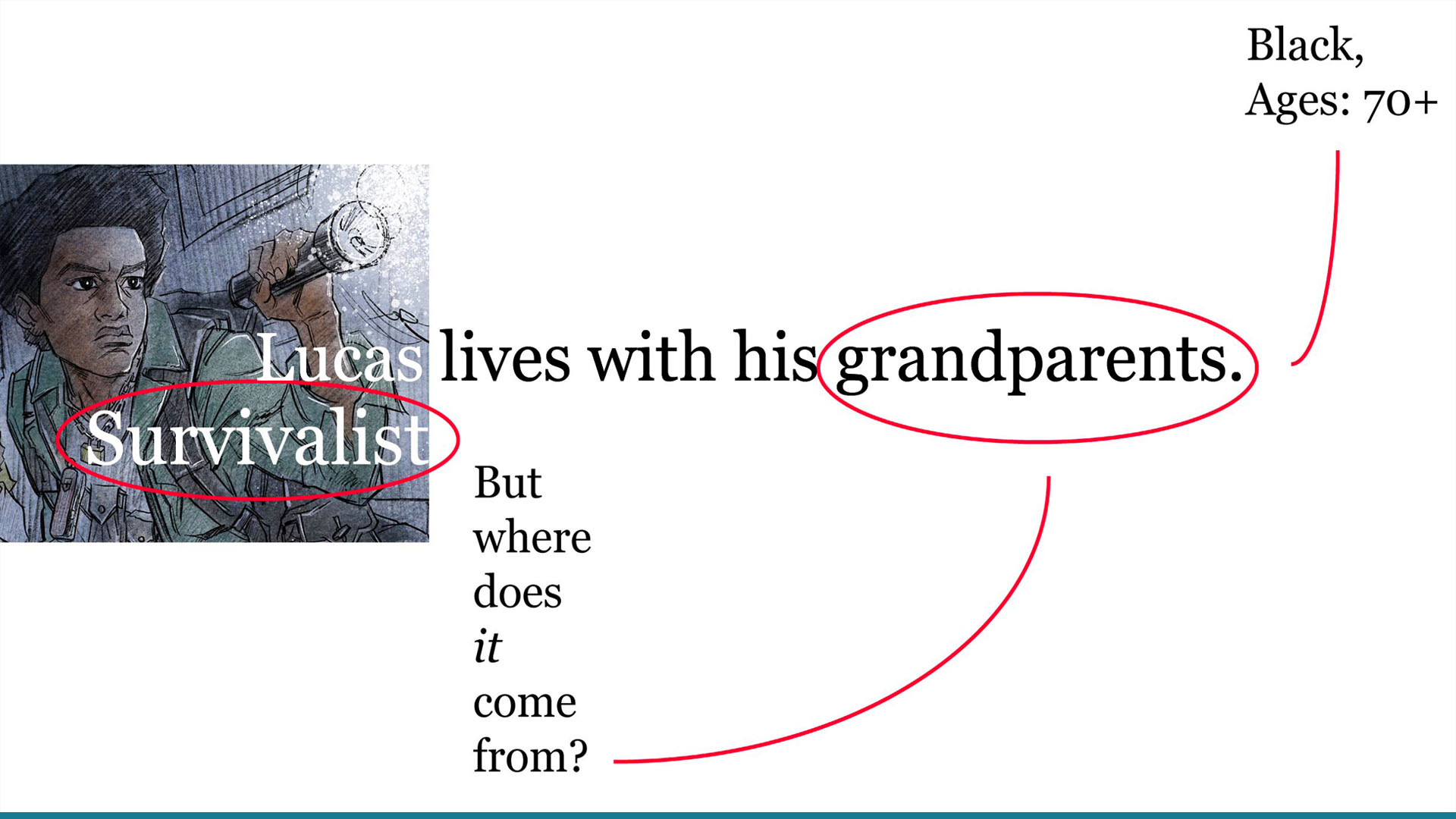Without music and dialogue, movies are just a series of photographs with intentional meanings. Those photographs are placed in a specific order, like how the right words are written in the right order to make a sentence. Storyboarding and film editing (the acts of putting those photographs in a sequence) is, to a degree, a language with rules.
“Storyboarding and film editing (the acts of putting those photographs in a sequence) is, to a degree, a language with rules.”
I teach middle school students filmmaking using English principles as a through line. For example… explaining what a movie close-up is by exploring how an adjective relays information.
We’re in preproduction of our very own animated film; my students picked their own film departments. My photography/video team is responsible for directing the film. Part of directing can be described as the following: Where do you put the camera and why?
The answer? Knowing the context of a scene will tell you where to put the camera. Relating it to an English class… if you know the context of a sentence, you will know where to put the camera.
“How to Make a Silent Film Using a Sentence? Ask and answer questions.”
DIRECTING 101 – INSTRUCTION
One of our characters is a high school freshman named Lucas. Lucas lives with his mom and his grandparents. But the relationship with his grandparents is the focus here (I simplified the sentence for this example):
 Lucas is the Survivalist of his friend group. But where does it come from? We decided that his grandparents (age: 70s) nurtured that side of him. The older black couple, who lived through the Civil Rights movement, would take an old school approach with him: Be Prepared, Be Ready.
Lucas is the Survivalist of his friend group. But where does it come from? We decided that his grandparents (age: 70s) nurtured that side of him. The older black couple, who lived through the Civil Rights movement, would take an old school approach with him: Be Prepared, Be Ready.
 That relationship would be so influential that the three would be attached at the hip, especially in their home.
That relationship would be so influential that the three would be attached at the hip, especially in their home.
To show the importance of that relationship, where do you put the camera? There are other answers that are more complicated, but the easiest answer is to make sure Lucas and at least one of his grandparents are in the same frame at all times.
Because we know the context of their relationship, because we understand the sentence, we know how to frame the shot.
The next example will be more complicated, so some BETTER NOTES are in order.
1.) A close-up is like an adjective; both offer understanding through close proximity. Think of a description that’s really specific. a red car with a busted light and a broken muffler, but a brand new engine. The more you examine it, the more you learn about it, like a close-up in a movie that just keeps zooming in on a subject.
2.) A wide shot is like a sentence/paragraph; they offer understanding by seeing the complete picture. But a wide shot can also act as a paragraph break: They both reset action.
3.) A conjunction like the word but can act as a transition in a scene. And it can be represented simply as a change of an angle.
With that said…
THE SILENT FILM – ACTIVITY FOR STUDENTS
What you will need:
Since we’re shooting still images, you will need some kind of camera. Cell phone cameras or iPad/tablet cameras also work.
Also, feel free to write your own sentence, just make sure you include a conjunction.
Consider the following sentence:
 Now, have the students answer the following questions about the sentence. There are no wrong responses:
Now, have the students answer the following questions about the sentence. There are no wrong responses:
 Notes on the sentences:
Notes on the sentences:
1.) If it’s a big book, you can possibly frame it so it takes up the entirety of the shot.
2.) If someone picked the book, it might be important to them. How do you show that with an image?
3.) The grade may dictate what the other kids are doing and the setting.
4.) What does the word alone really mean? And can that be conveyed as a wide shot or a close-up?
5.) If the other students are doing something seemingly more exciting than reading a book, it could show how focused the brothers are with the book.
6.) You can show how they feel about joining the group by showing how they treat the book.
Now, have the students draw a series of boxes like this.
 Now, instruct them to direct each answer by writing the responses in each box, using the BETTER NOTES from above and the LUCAS LIVES WITH HIS GRANDPARENTS lesson. These are like storyboards. (Illustrating the answers could work, but storyboard art is difficult.)
Now, instruct them to direct each answer by writing the responses in each box, using the BETTER NOTES from above and the LUCAS LIVES WITH HIS GRANDPARENTS lesson. These are like storyboards. (Illustrating the answers could work, but storyboard art is difficult.)
Finally, break the students into groups and have them take turns shooting their own scene. One will be the director and the rest will be the actors.
Once the pictures are photographed… put them on a computer, place them in order, and watch each silent film. How well did they articulate their sentences?
Yeah, but I don’t teach English. What should I do?
This lesson was originally conceived as an extension of an English lesson, but that doesn’t mean it’s restricted to that subject. History as a subject would be the closest “relative” to English and the easiest to pull context from its sentences.
But this lesson can also be applied to the likes of Math and Science. If you think of word problem in algebra where the point is to solve for a single variable or x (for example), you have everything needed for your Silent Film sentence, including a transition/conjunction, a close-up (what’s the first action to do?) and a wide shot (what’s the bigger picture?). Science is rife with beginnings, transitions, and new status quos.
Whether the subject is English or Social Studies, find the sentence and learn as much as you can about it. Ask questions and frame the narrative.
Here’s a video pulling this all together.
Resources
Please login or register to claim PGPs.
Alternatively, you may use the PGP Request Form if you prefer to not register an account.



